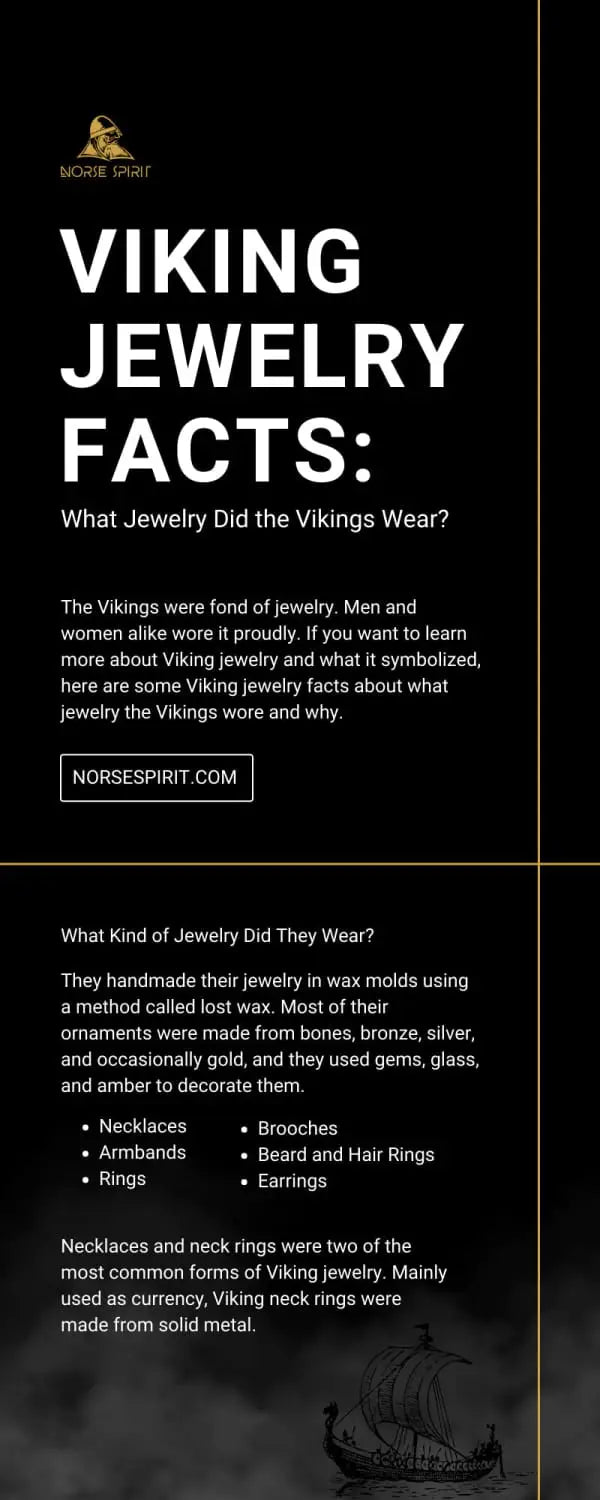Your Cart is Empty
Menu
-
- Shop by Type
- End of Line Sale Items
- New In
- Viking Gifts Under $30
- Hand Forged Axes
- Silver Viking Jewelry
- Stainless Steel Jewelry
- Cremation Jewelry
- Necklaces and Pendants
- Hand Carved Wooden Pendants
- Kings Chains
- Viking Drinking Horns
- Pendant Chains
- Rings
- Bracelets
- Earrings
- Beard Beads and Beard Rings
- Collectables
- Ceramic Mugs
- Street Wear
- Horn Jewelry
- Bronze and Pewter Jewelry
- Shop by Theme
- Viking Axe
- Celtic Jewelry
- Dragon or Serpent
- Viking Raven
- Wolf / Fenrir
- Rune Jewelry
- Odin Jewelry
- Ram / Goat
- Shieldmaidens / Lagertha
- Sword, Spear or Arrow
- Thor's Hammer / Mjolnir
- Tree of Life / Yggdrasil
- Helm of Awe / Aegishjalmur
- Triquetra or Triskelion
- Valknut / Knot of Slain
- Vegvisir / Viking Compass
- Veles / Bear
- Blogs
- Help
-
- Login

Viking Jewelry Facts: What Jewelry Did the Vikings Wear?

The Vikings were fond of jewelry. Men and women alike wore it proudly. If you want to learn more about Viking jewelry and what it symbolized, here are some Viking jewelry facts about what jewelry the Vikings wore and why.
Vikings Wore Jewelry?
People often express surprise upon learning that the Vikings did, in fact, wear jewelry. That’s because the typical modern image of a Viking is that of a burly, dirty, axe-wielding man. But in reality, the Vikings put a huge emphasis on their appearance and were clean, well-dressed, and well-groomed. Most Norsemen and Norsewomen wore jewelry; read on to learn why!
How Do We Know They Wore Jewelry?
How do we know the Vikings wore jewelry? Thanks to determined archeologists and historians who have recovered physical pieces of jewelry from graves and found mentions of jewelry in old Norse texts! The Huxley and Silverdale Hoards, which uncovered hundreds of pieces of old Viking jewelry, are two significant discoveries that proved the Vikings’ love for jewelry. You can also find countless mentions of bodily adornments in old stories; for example, the Anglo-Saxon Chronicletells the story of King Guthrum’s promise to King Arthur with an armband. Firsthand accounts also tell tales of Viking jewelry; Ahmed ibn Fadland, a 10th-century Arab diplomat, once wrote how almost every Viking he met had gold or silver torques around their necks.
Why Did Vikings Wear Jewelry?
So why did the Vikings wear jewelry? For a few different reasons, actually. One reason they wore jewelry was to show off their status. The super-rich donned sparkling gold jewelry, while the commonfolk stuck to jewelry made from cheap, readily available materials such as bronze or small animal bones.
Another reason was to look nice. As we mentioned, the Vikings valued their appearances. Wearing jewelry made them look good not only to themselves but also to others.
Vikings also used jewelry for convenience. Women used brooches to hold up the straps on their smocks, and men used them to secure their cloaks.
Finally, the Norse used jewelry as alternates form of currency. Viking neckbands and armbands were divided into sections that the wearer could break off and use to purchase assorted goods.
What Kind of Jewelry Did They Wear?
Vikings wore all kinds of jewelry. They handmade their jewelry in wax molds using a method called lost wax. Most of their ornaments were made from bones, bronze, silver, and occasionally gold, and they used gems, glass, and amber to decorate them. Let’s examine the kinds of jewelry the Vikings wore and go over what you need to know about each piece.
Necklaces
Necklaces and neck rings were two of the most common forms of Viking jewelry. Mainly used as currency, Viking neck rings were made from solid metal. Necklaces were also made from metal. What distinguished them from neck rings was that they were ornamented with pendants. These pendants had spiritual connotations, and Vikings wore them in hopes of invoking protection and other boons from the Norse gods and goddesses. Thor’s hammer pendants were the most common, but there were also:
- Round pendants representing the solar star
- Tool pendants representing activity and fertility
- Stick pendants representing Gungnir, Odin’s spear
- Cubic seat pendants representing the thrones of Thor and Odin
- Pendants featuring a woman holding a horn, which represented the Valkyries, the women who guided slain men to Valhalla
Armbands
Armbands, also called arm rings, were another very popular type of Viking jewelry. Vikings wore them as accessories and also used them as currency. In Viking culture, armbands were often associated with oaths; Vikings would give others arm bands as oaths.
Another common use of armbands was for the “growing-up ritual,” in which a boy was given an armband to symbolize his transition from boy to man. Armbands were also symbols of love. Men would gift armbands to their wives to signify their love and loyalty to them.
Rings
The Vikings also wore rings on their fingers, but not until the later years of the Viking Age. Most of these rings had uneven widths and were penannular—or open ended—which allowed them to fit many different finger sizes. They were made with metal (usually gold) and inset with gems.
Brooches
The Norse used brooches to hold smocks, cloaks, and other pieces of clothing in place. Most brooches were plain, but well-off individuals wore elaborately carved brooches to show off their status. Women also often connected their two smock brooches with ornamental chains made from glass or amber. Round brooches were most common at the beginning of the Viking Age, but in the 10th century, disc-shaped brooches overtook oval domes as the clothes-holders of choice.
Beard and Hair Rings
Viking men were known for their impressive beards, while Viking women were purported to have long, shiny locks. Of course, long hair often meant unwieldy hair. To keep their hair out of the way while they fought, farmed, or performed other tasks, the Norse used beard and hair rings. These rings worked a lot like modern-day scrunchies: the Vikings would braid their hair and use the rings to keep the braids from unfurling. Not all rings were tight, though. Some were loose and worn in the hair merely as decoration.
Earrings
Early Vikings didn’t commonly wear earrings and other piercings, not because they disliked the look or feel of them but because they didn’t know much about this form of jewelry. However, many of the people they encountered on their travels did wear earrings, and eventually, the Vikings began experimenting with them as well. They wore earrings over the ear as cuffs or clasps rather than attached to the ear through a hole.
Though some of the fiercest warriors in history, the Vikings also enjoyed the finer things in life, such as fashion. If you’re a modern Viking who wants to act and look like the Vikings of old, pick up a Viking necklace or another piece of Norse jewelry from Norse Spirit. We have necklaces, armbands, rings, and more that will make you feel like a true Viking.

